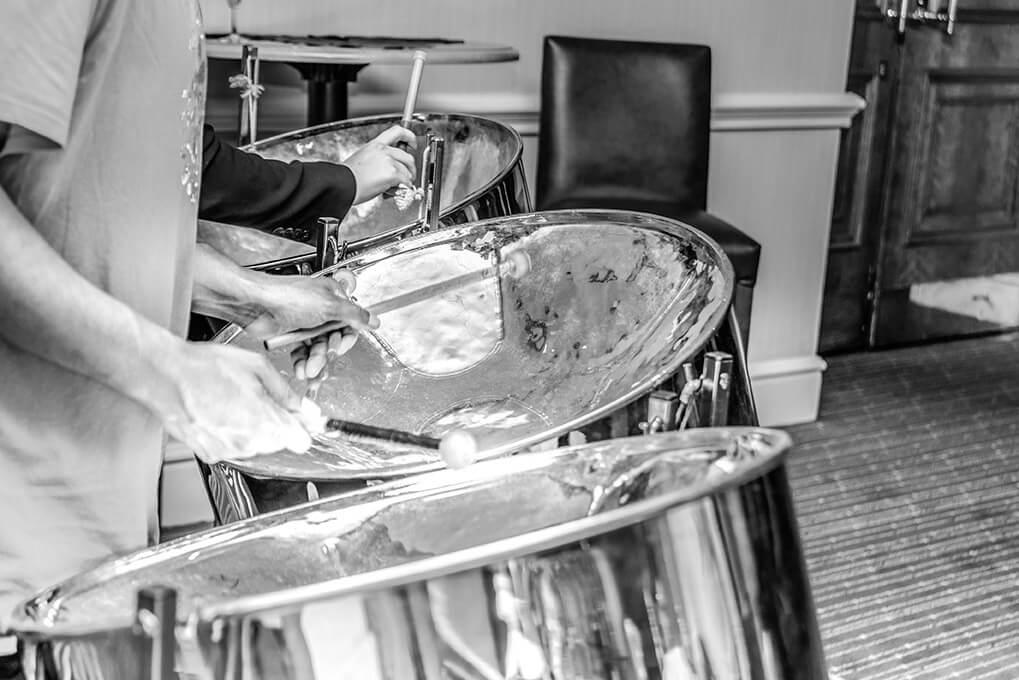What criteria should I look for when choosing a steel drum?
Which steel drum to choose and how to be sure of its quality? Once you have fallen under the spell of the steel drum's sweet melodies and have decided to buy an instrument, the question becomes inevitable. In order to determine which type of steel drum is right for you, it is important to know in which context you will use it. Do you want to be part of a steelband, accompany other instruments in a more classical musical formation, or play alone in your living room for the pleasure of its sounds?
Being clear about the future context of use of the instrument will allow you to orientate yourself in your future purchase.
A chromatic or diatonic steeldrum?
Like many musical instruments, steel drums are available in two types of instruments:
- Chromatic instruments, which contain all the tones of the scale and can therefore reproduce all melodies and chords.
- Diatonic instruments, which contain only the notes of a chosen scale (for example C D E F G A B C for a C major scale).
Although equal in terms of build quality or timbre, chromatic instruments allow you to play in any key, whereas diatonic instruments (commonly called "single pans") will only allow you to play in defined keys, as would a harmonica or diatonic accordion for example.
This first parameter will guide you in your purchase, depending on whether you plan to play harmonically elaborated music (classical, jazz, etc...), or rather certain traditional folk music.
Chromatic steel drum models
Apart from the soprano model ("tenor" in C or D), chromatic steel drums require from two to six drums depending on their tessitura (low or high) to be able to obtain all the necessary notes, which will certainly be an important criterion in the choice of your steel drum: a "six bass" is clearly not ideal if you live in a small flat, and cannot be transported in a car! So if you're a die-hard bass addict, you'll have to go for the five-note diatonic version, which will offer similar sounds with less space...
Chromatic instruments have more notes, and although the steeldrum is very easy to learn, they are also technically a little trickier to master.
The layout of the notes on the instruments is however very coherent and allows an almost immediate understanding of their pattern, based on a symmetrical arrangement of the notes between the different drums.
Diatonic steel drum models
With a smaller number of notes, diatonic instruments are systematically built on a single drum. These instruments were originally intended to be worn in musical parades, but their ease of learning and reduced logistical requirements quickly made them the instrument of choice for teaching, or simply for the player who wanted to play the steel drum without embarking on a heavy learning curve.
Simpler in design without sacrificing tone quality, the single steeldrum will generally be more affordable than the chromatic models.
What range should I choose for my steeldrum?
By range, we mean the frequency scale that the steeldrum delivers: it can be low-pitched like a double bass, or high-pitched like a violin...
Steeldrums - whether diatonic or chromatic - are available in several ranges, just like the strings in a symphony orchestra, and it is this very fact that makes it possible to compose an orchestra: the steelband.
However, each instrument, whether low or high, chromatic or diatonic, can be taken out of this context and mixed with other musical instruments, or played simply for pleasure.
In order to define the tessitura that suits you, you simply have to rely on your personal taste: do you prefer the high tinkling of a "tenor", the cathedral-like tone of a "cello", or the power of a bass?
From low to high, steel drums are mainly declined in several registers:
- The steeldrum six bass
This is the equivalent of the double bass in a symphony orchestra. It has 18 notes distributed over six drums. Although it is very pleasant to play, it is a logistically heavy instrument, and is generally only used in a steelband.
- The tenor bass steeldrum
A little higher pitched than the six bass, it often doubles the lines of the bass in the higher octave. The chromatic version is an excellent alternative to have a bass without the inconvenience of carrying a six bass (steelband or other musical formation). Its diatonic or single bass version is used as the main bass in diatonic steeldrum bands, and can make a perfect diatonic bass in other bands.
- The steeldrum cello
Made up of three to four drums, it is the equivalent of the cello in a symphony orchestra. It is an instrument with a powerful and majestic sound, although relatively cumbersome and technically more difficult to access.
- The steeldrum guitar
Composed of two drums in its chromatic version or "double guitar", its often rhythmic function requires a shorter tone so as not to mask the percussive side of the instrument. The diatonic version or "single guitar" offers the same qualities and abilities, following a full scale of eight or nine notes.
- The steeldrum second
Composed of two drums in its chromatic version or "double second", it is an instrument of great versatility, dedicated to both melody and accompaniment. The "single second" version is built on a single barrel, but delivers a chromatic register over a full octave. There is also a diatonic version of the second, which is an excellent teaching instrument with the same acoustic qualities as the chromatic version.
- The tenor (soprano) steeldrum
Systematically built on a single barrel, the reduced size of its notes makes it possible to obtain a complete chromatic register over more than two octaves: it is the emblematic steeldrum, dedicated to melody. Its comfortable chromatic range, ease of access and small size make it the most popular instrument in the family.
Painted or chromed steeldrum?
The choice of a painted or chrome finish is a matter of aesthetic taste and budget.
Chrome plating offers good corrosion protection, a dramatic aesthetic effect, and has a slight impact on the tone of the instrument. But as we explain in our article "How much does a steeldrum cost" the price of a chrome plated steeldrum will be significantly higher than that of a painted steeldrum.
A painted instrument will therefore be considerably cheaper, and easier to maintain or renovate. The paint will also affect the sound, with a tendency to limit the sustain (length of sound) slightly compared to chrome plating.
So now you know what type of steeldrum is best for you.
The question is how to choose a quality instrument. So here are some tips and advice to help you define what a good steel drum is.
How to define the quality of a steeldrum?
As detailed in the article on steeldrum making, the quality of the barrel is first and foremost the key to making a good steeldrum. As the steel used is relatively ordinary, the thickness of the bottom of the barrel guarantees the volume and stability of the instrument. The standard thickness recommended is 1.2 mm, and each manufacturer should be able to inform his future customer of the thickness of the drums he uses.
As the construction criteria are standardised, constructional faults are rare on the part of professional manufacturers. If in doubt, it is often sufficient to check the general roundness of the vessel and also its surface condition to ensure that the steel drum is of good quality.
In terms of acoustic behaviour, the instrument should be fair, balanced, and offer sufficient stability in normal playing conditions. If you do not have the opportunity to try it out, ask for an audio recording, or better still a good video of the steeldrum.
As with a piano, and since we cannot escape the laws of physics, it is normal for the extreme notes to have less definition (the lowest notes for a six-bass) or volume (the smallest notes of the "tenor", i.e. the high notes).
Finally, beyond the acoustic qualities of the instruments, it is also necessary to pay close attention to the quality of the finish, to ensure that the steeldrum is correctly protected against corrosion, whether it is a chromed or painted steeldrum. Indeed, it is not uncommon to see chrome or paint chips appearing after a few months if the finish of the surface treatment and coating is not of sufficient quality, especially if the drums come from islands where the salinity level is high.
Did you like this article? Would you like to receive more information about steel drums? Subscribe to our NEWSLETTER below!



